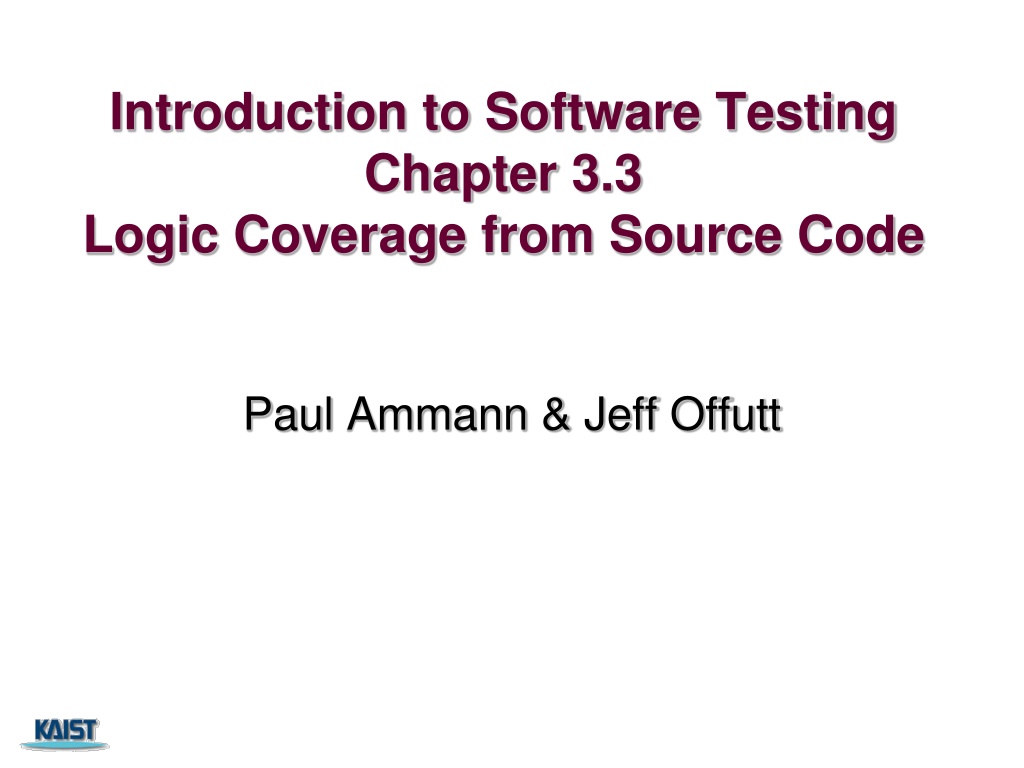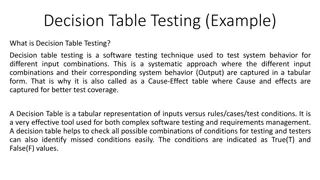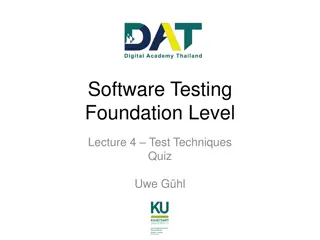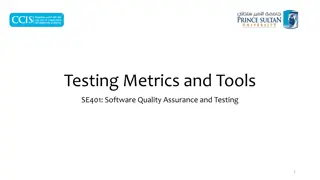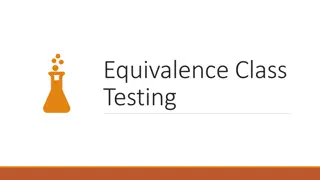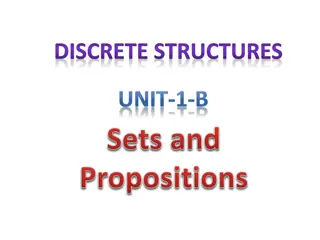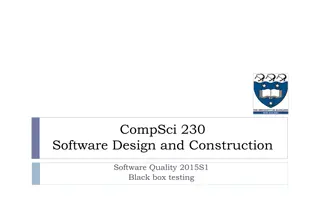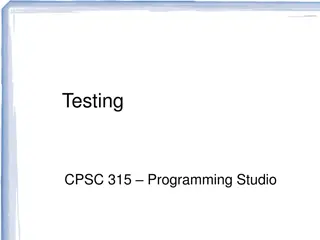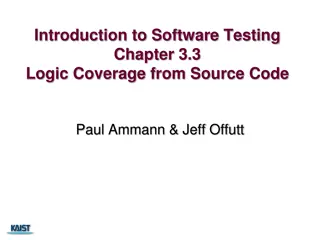Logic Coverage in Software Testing
Logic coverage from source code involves deriving predicates from decision statements in programs, where most predicates have less than four clauses. Wise programmers aim to keep predicates simple, as they affect coverage criteria such as COC, ACC, ICC, and CC, which collapse to predicate coverage (PC) when a predicate has only one clause. Applying logic criteria to program source is challenging due to reachability and controllability concerns, illustrated through examples like triangle verification routines.
Uploaded on Oct 03, 2024 | 0 Views
Download Presentation

Please find below an Image/Link to download the presentation.
The content on the website is provided AS IS for your information and personal use only. It may not be sold, licensed, or shared on other websites without obtaining consent from the author.If you encounter any issues during the download, it is possible that the publisher has removed the file from their server.
You are allowed to download the files provided on this website for personal or commercial use, subject to the condition that they are used lawfully. All files are the property of their respective owners.
The content on the website is provided AS IS for your information and personal use only. It may not be sold, licensed, or shared on other websites without obtaining consent from the author.
E N D
Presentation Transcript
Introduction to Software Testing Chapter 3.3 Logic Coverage from Source Code Paul Ammann & Jeff Offutt
Logic Expressions from Source Predicates are derived from decision statements in programs In programs, most predicates have less than four clauses Wise programmers actively strive to keep predicates simple When a predicate only has one clause, COC, ACC, ICC, and CC all collapse to predicate coverage (PC) Applying logic criteria to program source is hard because of reachability and controllability: Reachability : Before applying the criteria on a predicate at a particular statement, we have to get to that statement Controllability : We have to find input values that indirectly assign values to the variables in the predicates Variables in the predicates that are not inputs to the program are called internal variables These issues are illustrated through the triangle example in the following slides 2
30 private static int Triang (int s1, int s2, int s3) 31 { 32 int tri_out; 33 34 // tri_out is output from the routine: 35 // tri_out = 1 if triangle is scalene 36 // tri_out = 2 if triangle is isosceles 37 // tri_out = 3 if triangle is equilateral 38 // tri_out = 4 if not a triangle 39 40 // After a quick confirmation that it s a legal 41 // triangle, detect any sides of equal length 42 if (s1 <= 0 || s2 <= 0 || s3 <= 0) 43 { 44 tri_out = 4; 45 return (tri_out); 46 } 47 48 tri_out = 0; 49 if (s1 == s2) 50 tri_out = tri_out + 1; 51 if (s1 == s3) 52 tri_out = tri_out + 2; 53 if (s2 == s3) 54 tri_out = tri_out + 3; 55 if (tri_out == 0) 56 { // Confirm it s a legal triangle before declaring 57 // it to be scalene 59 if (s1+s2<=s3||s2+s3 <= s1 60 || s1+s3 <= s2) 61 tri_out = 4; 62 else 63 tri_out = 1; 64 return (tri_out); 65 } 67 /* Confirm it s a legal triangle before declaring 68 it to be isosceles or equilateral */ 69 70 if (tri_out > 3) 71 tri_out = 3; 72 else if (tri_out == 1 && s1+s2 > s3) 73 tri_out = 2; 74 else if (tri_out == 2 && s1+s3 > s2) 75 tri_out = 2; 76 else if (tri_out == 3 && s2+s3 > s1) 77 tri_out = 2; 78 else 79 tri_out = 4; 80 return (tri_out); 81 } // end Triang 3
Ten Triangle Predicates 42: (s1 <= 0 || s2 <= 0 || s3 <= 0) 49: (s1 == s2) 51: (s1 == s3) 53: (s2 == s3) 55: (triOut == 0) 59: (s1+s2 <= s3 || s2+s3 <= s1 || s1+s3 <= s2) 70: (triOut > 3) 72: (triOut == 1 && s1+s2 > s3) 74: (triOut == 2 && s1+s3 > s2) 76: (triOut == 3 && s2+s3 > s1) 4
Reachability for Triang Predicates 42: True 49: P1 = s1>0 && s2>0 && s3>0 51: P1 53: P1 55: P1 59: P1 && triOut = 0 62: P1 && triOut = 0 && (s1+s2 > s3) && (s2+s3 > s1) && (s1+s3 > s2) 70: P1 && triOut != 0 72: P1 && triOut != 0 && triOut <= 3 74: P1 && triOut != 0 && triOut <= 3 && (triOut !=1 || s1+s2<=s3) 76: P1 && triOut != 0 && triOut <= 3 && (triOut !=1 || s1+s2<=s3) && (triOut !=2 || s1+s3<=s2) 78: P1 && triOut != 0 && triOut <= 3 && (triOut !=1 || s1+s2<=s3) && (triOut !=2 || s1+s3 <= s2) && (triOut !=3 || s2+s3 <= s1) Need to solve for the internal variable triOut 5
Solving for Internal Variable triOut At line 55, triOut has a value in the range (0 .. 6) triOut = 0 s1!=s2 && s1!=s3 && s2!=s3 1 s1=s2 && s1!=s3 && s2!=s3 2 s1!=s2 && s1=s3 && s2!=s3 3 s1!=s2 && s1!=s3 && s2=s3 4 s1=s2 && s1!=s3 && s2=s3 5 s1!=s2 && s1=s3 && s2=s3 6 s1=s2 && s1=s3 && s2=s3 Contradiction Contradiction 6
Reachability for Triang Predicates (solved for triOut reduced) 42: True 49: P1 = s1>0 && s2>0 && s3>0 51: P1 53: P1 55: P1 59: P1 && s1 != s2 && s2 != s3 && s2 != s3 (triOut = 0) 62: P1 && s1 != s2 && s2 != s3 && s2 != s3 (triOut = 0) && (s1+s2 > s3) && (s2+s3 > s1) && (s1+s3 > s2) 70: P1 && P2 = (s1=s2 || s1=s3 || s2=s3) (triOut != 0) 72: P1 && P2 && P3 = (s1!=s2 || s1!=s3 || s2!=s3) (triOut <= 3) 74: P1 && P2 && P3 && (s1 != s2 || s1+s2<=s3) 76: P1 && P2 && P3 && (s1 != s2 || s1+s2<=s3) && (s1 != s3 || s1+s3<=s2) 78: P1 && P2 && P3 && (s1 != s2 || s1+s2<=s3) && (s1 != s3 || s1+s3<=s2) && (s2 != s3 || s2+s3<=s1) Looks complicated, but a lot of redundancy 7
Predicate Coverage These values are don t care , needed to complete the test. T F s1 s2 s3 s1 s2 s3 0 0 0 1 1 1 1 1 1 1 2 2 1 1 1 1 2 2 1 1 1 2 1 2 1 2 3 1 1 1 p42: (s1 <= 0 || s2 <= 0 || s3 <= 0) p49: (s1 == s2) p51: (s1 == s3) p53: (s2 == s3) p55: (triOut == 0) p59: (s1+s2 <= s3 || s2+s3 <= s1 || s1+s3 <= s2) p70: (triOut > 3) p72: (triOut == 1 && s1+s2 > s3) p74: (triOut == 2 && s1+s3 > s2) p76: (triOut == 3 && s2+s3 > s1) 1 2 3 2 3 4 1 1 1 2 2 3 2 2 3 2 2 4 2 3 2 2 4 2 3 2 2 4 2 2 8
Clause Coverage T F s1 s2 s3 EO s1 s2 s3 EO 0 1 1 4 1 1 1 3 1 0 1 4 1 1 1 3 1 1 0 4 1 1 1 3 2 3 6 4 2 3 4 1 6 2 3 4 2 3 4 1 2 6 3 4 2 3 4 1 2 2 3 2 2 3 2 2 2 2 3 2 2 2 5 4 2 3 2 2 3 2 2 2 2 3 2 2 2 5 2 4 3 2 2 2 1 2 1 4 3 2 2 2 5 2 2 4 p42: (s1 <= 0) (s2 <= 0 ) (s3 <= 0) p59: (s1+s2 <= s3 ) (s2+s3 <= s1) (s1+s3 <= s2) p72: (triOut == 1) (s1+s2 > s3) p74: (triOut == 2) (s1+s3 > s2) p76: (triOut == 3) (s2+s3 > s1) 9
Correlated Active Clause Coverage P s1 s2 s3 EO T f f t 0 1 1 4 F F F f 1 1 1 3 f T f t 1 0 1 4 f f T t 1 1 0 4 T f f t 2 3 6 4 F F F f 2 3 4 1 f T f t 6 2 3 4 f f T t 2 6 3 4 T T t 2 2 3 2 F t f 2 3 3 2 t F f 2 2 5 4 T T t 2 3 2 2 F t f 2 3 3 2 t F f 2 5 2 4 T T t 3 2 2 2 F t f 1 2 2 4 t F f 5 2 2 4 p42: (s1 <= 0 || s2 <= 0 || s3 <= 0) p59: (s1+s2 <= s3 || s2+s3 <= s1 || s1+s3 <= s2) p72: (triOut == 1 && s1+s2 > s3) s1=s2 && s1!=s3 && s2!=s3 p74: (triOut == 2 && s1+s3 > s2) s1!=s2 && s1=s3 && s2!=s3 p76: (triOut == 3 && s2+s3 > s1) s1!=s2 && s1!=s3 && s2=s3 10
Summary : Logic Coverage for Source Code Predicates appear in decision statements if, while, for, etc. Most predicates have less than four clauses But some applications have predicates with many clauses The hard part of applying logic criteria to source is resolving the internal variables Non-local variables (class, global, etc.) are also input variables if they are used If an input variable is changed within a method, it is treated as an internal variable thereafter To maximize effect of logic coverage criteria: Avoid transformations that hide predicate structure 11
